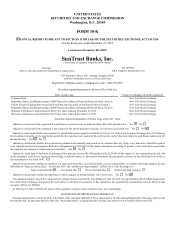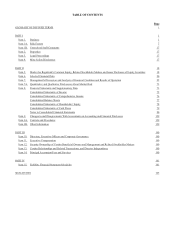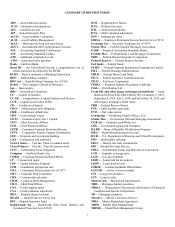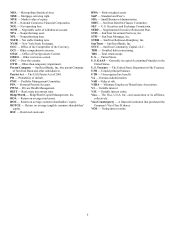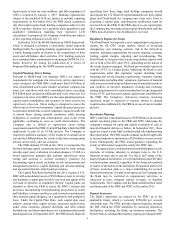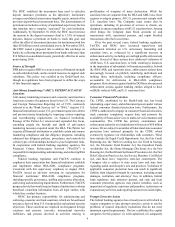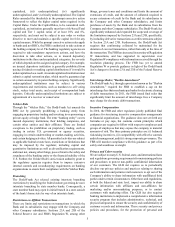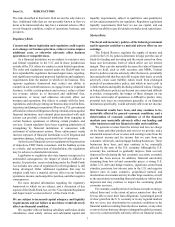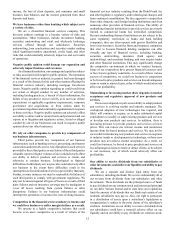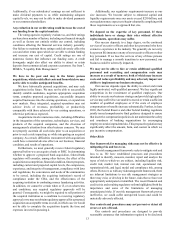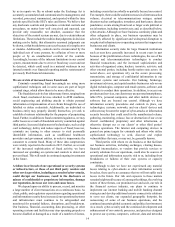SunTrust 2015 Annual Report Download - page 32
Download and view the complete annual report
Please find page 32 of the 2015 SunTrust annual report below. You can navigate through the pages in the report by either clicking on the pages listed below, or by using the keyword search tool below to find specific information within the annual report.4
The FDIC redefined the assessment base used to calculate
deposit insurance premiums as the depository institution's
average consolidated assets minus tangible equity, instead of the
previous deposit-based assessment base. The determination of
premium rate includes a variety of capital and supervisory factors
that translate into a complex “scorecard” for each institution.
Additionally, by September 30, 2020, the FDIC must increase
the amount in the deposit insurance fund to 1.35% of insured
deposits, impose a premium on banks to reach this goal, and
offset the effect of assessment increases for institutions with less
than $10 billion in total consolidated assets. In November 2015,
the FDIC issued a proposed rule to address this surcharge on
banks, by collecting those premiums from banks with more than
$10 billion in consolidated assets, potentially effective at some
point during 2016.
Source of Strength
FRB policy requires BHCs to act as a source of financial strength
to each subsidiary bank, and to commit resources to support each
subsidiary. This policy was codified in the Dodd-Frank Act,
though no regulations have been proposed to define the scope
of this financial support.
Anti-Money Laundering (“AML”), PATRIOT ACT; OFAC
Sanctions
Anti-money laundering measures and economic sanctions have
long been a matter of regulatory focus in the U.S. The Currency
and Foreign Transactions Reporting Act of 1970, commonly
referred to as the "Bank Secrecy Act" or "BSA," requires U.S.
financial institutions to assist U.S. government agencies to detect
and prevent money laundering by imposing various reporting
and recordkeeping requirements on financial institutions.
Passage of the Patriot Act renewed and expanded this focus,
extending greatly the breadth and depth of anti-money
laundering measures required under the BSA. The Patriot Act
requires all financial institutions to establish certain anti-money
laundering compliance and due diligence programs, including
enhanced due diligence policies, procedures, and controls for
certain types of relationships deemed to pose heightened risks.
In cooperation with federal banking regulatory agencies, the
Financial Crimes Enforcement Network ("FinCEN") is
responsible for implementing, administering, and enforcing BSA
compliance.
Federal banking regulators and FinCEN continue to
emphasize their expectation that financial institutions establish
and implement robust BSA/AML compliance programs.
Consistent with this supervisory emphasis, in August 2014,
FinCEN issued an advisory stressing its expectations for
financial institutions’ BSA/AML compliance programs,
including specific governance, staffing and resource allocation,
and testing and monitoring requirements. Furthermore, FinCEN
proposed a rule that would require financial institutions to obtain
beneficial ownership information from all legal entities with
which they conduct business.
OFAC has primary responsibility for administering and
enforcing economic and trade sanctions, which are broad-based
measures, derived from U.S. foreign policy and national security
objectives. These sanctions are imposed on designated foreign
countries and persons, terrorists, international narcotics
traffickers, and persons involved in activities relating to
proliferation of weapons of mass destruction. While the
sanctions laws are separate from the BSA and AML laws, these
regimes overlap in purpose. All U.S. persons must comply with
U.S. sanctions laws. The Company must ensure that its
operations, including its provision of services to clients, are
designed to ensure compliance with U.S. sanctions laws. Among
other things, the Company must block accounts of, and
transactions with, sanctioned persons, and report blocked
transactions after their occurrence.
Over the past several years, federal banking regulators,
FinCEN, and OFAC have increased supervisory and
enforcement attention on U.S. anti-money laundering and
sanctions laws, as evidenced by a significant increase in
enforcement activity, including several high profile enforcement
actions. Several of these actions have addressed violations of
AML laws, U.S. sanctions laws, or both, resulting in instances
in the imposition of substantial civil monetary penalties. In both
the BSA/AML and sanctions areas, enforcement actions have
increasingly focused on publicly identifying individuals and
holding those individuals, including compliance officers,
accountable for deficiencies in BSA/AML compliance
programs. State attorneys general and the DOJ have also pursued
enforcement actions against banking entities alleged to have
willfully violated AML and U.S. sanctions laws.
Consumer Financial Protection
The CFPB, established by the Dodd-Frank Act, has broad
rulemaking, supervisory, and enforcement powers under various
federal consumer financial protection laws. Furthermore, the
CFPB is authorized to engage in consumer financial education,
track consumer complaints, request data, and promote the
availability of financial services to under-served consumers and
communities. The CFPB has primary examination and
enforcement authority over institutions with assets of $10 billion
or more. We are subject to a number of federal and state consumer
protection laws enforced primarily by the CFPB, which
extensively regulates our relationships with customers. These
laws include the Equal Credit Opportunity Act, the Fair Credit
Reporting Act, the Truth in Lending Act, the Truth in Savings
Act, the Electronic Fund Transfer Act, the Expedited Funds
Availability Act, the Home Mortgage Disclosure Act, the Fair
Housing Act, the Real Estate Settlement Procedures Act, the Fair
Debt Collection Practices Act, the Service Members Civil Relief
Act, and these laws’ respective state-law counterparts. The
Company also is subject to state usury laws and state laws
regarding unfair and deceptive acts and practices. Violations of
applicable consumer protection laws can result in significant
liability from litigation brought by customers, including actual
damages, restitution, and attorneys’ fees. In addition, federal
bank regulators, state attorneys general, and state and local
consumer protection agencies may pursue remedies, such as
imposition of regulatory sanctions and penalties, restrictions on
expansionary activities, and requiring customer rescission rights.
Prompt Corrective Action
The federal banking agencies have broad powers with which to
require companies to take prompt corrective action to resolve
problems of insured depository institutions that do not meet
minimum capital requirements. The law establishes five capital
categories for this purpose: (i) well-capitalized, (ii) adequately





